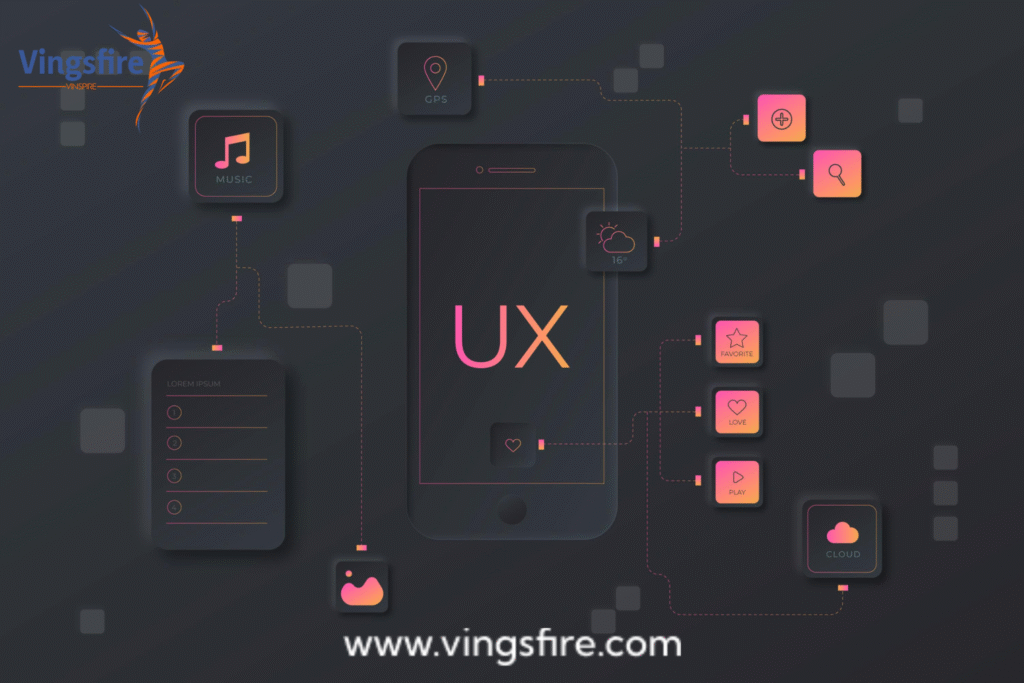
In today’s digital-first world, UI design has become the silent ambassador of your brand. With users forming opinions about websites in just 50 milliseconds, professional UI design is no longer a luxury—it’s a business necessity. At Vingsfire, we’ve transformed countless digital products through strategic UI design that combines aesthetic appeal with functional excellence.
This comprehensive guide will explore:
- The fundamental principles of modern Interface Design
- 7 psychological triggers that make interfaces irresistible
- The complete Interface Design workflow from concept to implementation
- Industry-specific Interface Design best practices
- Common Interface Design mistakes that sabotage conversions
- Emerging trends redefining visual interfaces
- How to choose the right Interface Design partner
What is UI Design? (The 2025 Definition)
Interface Design (User Interface design) focuses on crafting the visual and interactive elements of digital products. It’s the art of creating interfaces that are:
✔ Visually appealing
✔ Intuitively navigable
✔ Emotionally engaging
✔ Technically functional
Modern Interface Design encompasses:
- Visual Design: Color schemes, typography, iconography
- Interactive Elements: Buttons, menus, micro-interactions
- Layout Structure: Grid systems, spacing, visual hierarchy
- Responsive Adaptation: Mobile, tablet, desktop variations
- Design Systems: Reusable component libraries
UI Design vs. UX Design
| Aspect | UI Design | UX Design |
|---|---|---|
| Focus | Visual presentation | Overall user experience |
| Tools | Figma, Sketch, Adobe XD | User research, analytics |
| Output | High-fidelity mockups | User flows, wireframes |
| Success Metrics | Visual consistency | Task completion rates |
7 Psychological Principles for Powerful UI Design
1. The Von Restorff Effect
Make important elements stand out through contrast
2. Fitts’s Law
Size and position interactive elements for easy access
3. The Aesthetic-Usability Effect
Beautiful designs are perceived as more functional
4. The Law of Similarity
Group related elements through visual consistency
5. The Zeigarnik Effect
Use progress indicators for multi-step processes
6. The Serial Position Effect
Place key actions at the beginning and end of flows
7. The Gestalt Principles
Leverage proximity, closure, and continuity for intuitive layouts
The UI Design Process: Step-by-Step
1. Discovery & Research
- Analyze brand guidelines
- Study competitor interfaces
- Gather stakeholder input
2. Mood Boarding
- Collect visual inspiration
- Define color palettes
- Select typography
3. Wireframing
- Create low-fidelity layouts
- Establish information hierarchy
- Plan responsive behavior
4. Visual Design
- Develop high-fidelity mockups
- Design interactive components
- Create micro-interactions
5. Prototyping
- Build clickable prototypes
- Test animations
- Validate interactions
6. Handoff & Implementation
- Create design systems
- Prepare developer assets
- Ensure pixel-perfect execution
7. Quality Assurance
- Verify visual consistency
- Test across devices
- Refine based on feedback
Industry-Specific UI Design Applications
E-Commerce
- Product card designs
- Shopping cart optimization
- Promotional banner styles
FinTech
- Data visualization dashboards
- Secure transaction interfaces
- Mobile banking components
Healthcare
- Patient portal interfaces
- Medical data displays
- Appointment scheduling UIs
SaaS
- Dashboard layouts
- Feature discovery patterns
- Settings panel organization
5 Costly Interface Design Mistakes to Avoid
⚠ Inconsistent Visual Language – Confuses and frustrates users
⚠ Poor Contrast Ratios – Makes interfaces inaccessible
⚠ Overly Complex Navigation – Increases cognitive load
⚠ Ignoring Mobile Users – 60% of web traffic comes from mobile
⚠ Neglecting Loading States – Creates perception of broken interfaces
Emerging UI Design Trends for 2025
🔮 Neumorphism 2.0 – Subtle, accessible skeuomorphism
🔮 Glass Morphism – Frosted glass effects with depth
🔮 Animated Illustrations – Engaging motion graphics
🔮 3D Elements – Immersive interface components
🔮 Dynamic Color Systems – Context-aware palettes
Why Choose Vingsfire for Interface Design?
Our UI design services deliver:
- Brand-Aligned Visuals – Interfaces that reflect your identity
- Conversion-Optimized Layouts – Designs that drive business goals
- Cross-Platform Consistency – Seamless experiences across devices
- Future-Ready Solutions – Implementing cutting-edge trends
Conclusion: The Business Impact of Great UI Design
Exceptional Interface Design directly impacts your bottom line by:
- Increasing conversion rates by up to 200%
- Boosting user engagement by 300%
- Reducing bounce rates by 40%
- Improving brand perception by 70%
Ready to elevate your digital presence? Vingsfire offers free UI design consultations to transform your product.
